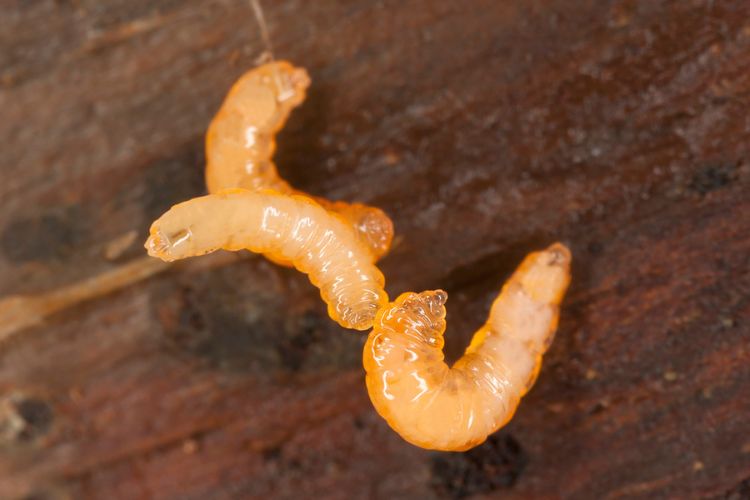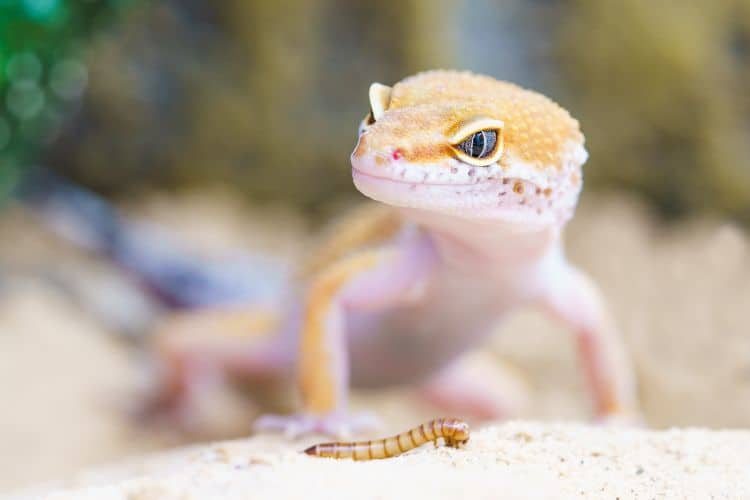The alluring, wiggly form of a wax worm can be hard to resist, even for a discerning eater like a leopard gecko.
But can leopard geckos eat wax worms, and are they a healthy addition to their diet?
In this article, we’ll explore the nutritional value of wax worms for leopard geckos and discuss how to incorporate them into your gecko’s feeding routine properly.
Can Leopard Geckos Eat Wax Worms? Yes, but Moderation Is Key
Yes, leopard geckos can eat wax worms, but only in moderation.
Wax worms, along with their adult-form wax moths, are high in fat, so they should be given as a treat for your gecko rather than as a staple part of their diet. It’s similar to us eating candy—it’s okay once in a while, but not all the time because it’s not the healthiest option.
If you feed your leopard gecko too many wax worms, they could get overweight, which isn’t good for their health. So, it’s best to offer wax worms as an occasional snack, maybe once or twice a week at most.
When giving wax worms to your leopard gecko, remember to dust them with a
This ensures that your gecko gets the necessary nutrients to stay healthy.
Calcium is crucial for their bone strength, while vitamin D3 helps them absorb the
Also, make sure the wax worms are the right size for your gecko. You want to give them something manageable so that they can eat or digest properly. Always keep an eye on your gecko’s weight and adjust their diet accordingly to keep them happy and healthy.

Reasons Why Wax Worms Aren’t Good For Leopard Geckos
While they may seem like a delicious treat, offering wax worms to your leopard gecko too often could lead to health problems. Here’s why:
Poor Nutritional Value
Leopard geckos need protein for growth and muscle development, and
A diet lacking in
In female leopard geckos,
Here’s a comparison table of the nutritional value of waxworms compared to other common feeder insects:
| Nutrient (per 100 grams) | Wax Worms | Mealworms | Crickets | Dubia Roaches |
| Protein | 15.5g | 20.27g | 20.5g | 23.4g |
| Fat | 23.8g | 14.22g | 6.7g | 7.2g |
| Calcium | 20mg | 10mg | 15mg | 400mg |
| Phosphorus | 185mg | 206mg | 252mg | 280mg |
| Fiber | 1.1g | 2.6g | 1.3g | 3.4g |
| Moisture | 58.7g | 59.9g | 75.9g | 61.2g |
| Ash | 0.7g | 1.2g | 0.9g | 1.3g |
The table above shows that wax worms have more fat compared to mealworms and crickets, but they have less protein.
Also, wax worms don’t have as much
Dubia roaches are even better because they have lots of protein and a good balance of
High-Fat Content
Wax worms have a lot more fat than other common feeder insects for leopard geckos, like crickets or mealworms.
For instance, per 100 grams, wax worms have about 23.8 grams of fat, while crickets only have about 6.5 grams, and mealworms have around 14 grams.
Too much fat in their diet can make geckos overweight and cause health problems like fatty liver disease, which can affect their liver function and overall health.
Potential For Addiction
Just like we might crave chips or candy, geckos might start preferring wax worms over healthier foods.
This can make it harder for them to enjoy a balanced diet and can lead to health issues if they don’t eat other nutritious insects.

How to Feed Wax Worms to Leopard Geckos
To make wax worms a bit healthier for your leopard geckos, there are a few things you can do.
One option is to dust the worms lightly with a
Another trick is to use wax worms as a high-value reward during training sessions or when you need to stimulate your gecko’s appetite.
Since wax worms are quite tasty to geckos, offering them as a special treat can encourage your gecko to eat other, more nutritious foods as well.
If your gecko needs to gain weight, like after growing back a lost tail or getting better from being sick, wax worms can be a good choice.
They’re high in fat, which gives your gecko lots of energy to help them recover. This extra boost can be really helpful for geckos trying to build up their strength again after being sick or injured.
By giving your gecko wax worms along with other healthy foods, you can help them get back to feeling their best in no time!
Final Thoughts
Yes, leopard geckos can eat wax worms, but they should be given in moderation as they are high in fat. It’s best to offer them as an occasional treat, like once or twice a week tops.
Giving them too often might make your gecko prefer them over other healthier foods, which could lead to health problems in the long run. So, moderation is key!

